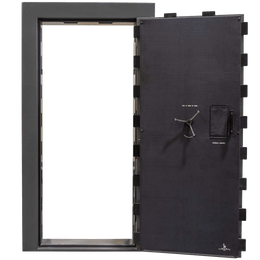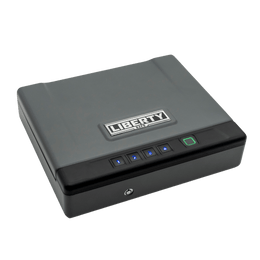A firearm or similar weapon that can only be wielded by its owner or another authorized, legal user has been the dream of science fiction writers, firearm innovators, gun safety advocates, and politicians since the 1950s. (Actually, lore about sentient swords and other intelligent weapons goes back as far as Hindu and Norse mythology.) If sufficiently reliable, such Smart Gun technology would have obvious benefits in preventing firearm accidents and possibly reducing gun-related crime. However, therein lies the rub: reliability. Above all else, a defensive firearm must be reliable when you absolutely need it. Your life, or the life of your loved ones, depends upon it.
There have been multiple attempts at creating a reliable, technologically advanced smart gun, using a wide range of mechanical, biometric, and electronic security features. Most have come to naught, but there have been some interesting developments over the past few years that have a chance of changing the defensive firearms market in a profound way. In this article, we’re going to go over the rocky history of smart guns, but first, we’ll clue you in on the latest innovations in smart gun technology.
Biofire Smart Gun
Widely publicized as the first commercially available smart gun (more on that later), the Biofire Smart Gun has been in development since 2016, and prototypes began hitting the big firearms industry shows around 2023. The 9mm Biofire pistol has generated significant buzz both inside and outside of the usual firearms journalism audience. Generally speaking, gun rights groups and people who actually know and use firearms are extremely skeptical of any gun that relies on complicated and potentially unreliable tech to function. On the other hand, gun safety groups and more, shall we say, restrictive state governments are anxious to embrace (and legislate in favor of) smart gun technology because they feel it may reduce criminal or accidental misuse of firearms. The debate rages on, and thus, smart gun technology has had a lot of potentially problematic political baggage associated with it over the years. However, despite a lot of skepticism from traditional gun enthusiasts, there is a legitimate market for a home defense and/or personal defense firearm that is reliable, effective, and which can only be operated by its owner or another authorized user.
Biofire’s youthful founder and CEO, Kai Kloepfer, came up with the main concept of the new pistol as a high-schooler, after several high-profile shootings in Colorado made him long for a way to help prevent misuse of firearms. Kloepfer attended MIT but dropped out to focus on Biofire full time, and the startup now employs over 30 people and has raised $40 million from venture capital firms as of 2024.
Despite an obvious desire to help reduce firearm-related deaths and injuries, Kloepfer is careful to avoid supporting government mandates for smart gun tech. The company posted on its social media account the following: Biofire does not support any government mandates for this or any other new firearm technology. Mandates stifle innovation in safety technology like what we build here. We are and always will be against mandates restricting your right to choose the right firearm.
This is important because an infamous 2002 New Jersey law regarding smart guns would have effectively eliminated all other firearms sales in the state once a viable smart gun became available on the market. The law was a primary factor in stifling serious development of smart gun innovation. At the same time, it remained in effect, since no gun manufacturer wanted to be associated with such a draconian government mandate, for fear of losing their primary customer base. The New Jersey law has since been softened (as of 2019), and now states that once reliable smart guns hit the market, New Jersey gun stores must simply offer one such model to their customers and inform them of the option.
Image Courtesy of Biofire
So far, despite a lot of hype, the Biofire Smart Gun has still not been launched into the general market. The company has stated that they will not start selling production pistols until they are absolutely reliable, and that benchmark has ostensibly not yet been met as of summer 2025. However, the Biofire concept has a lot going for it, compared to earlier attempts at the smart gun. Biofire has taken great strides in addressing some of the primary issues that plagued previous systems. Some of the interesting technological innovations touted by Biofire include:
- Biofire’s revolutionary Guardian Biometric Engine unlocks your Smart Gun in any situation, according to the company. The pistol’s integrated fingerprint identification and 3D infrared facial recognition systems independently verify your biometric data so your firearm can always recognize you, even if you wear gloves or a face covering. (Note that this is carefully worded to read gloves OR a face covering, as the dual-function security process requires either your fingerprint or your exposed face to be read by the pistol to activate it. If you have gloves AND a face covering on, you’ll want to find another solution.) Biofire’s facial recognition and fingerprint identification both function at full performance in total darkness.
- The Biofire pistol locks itself the moment it leaves your hand to prevent misuse if you set it down or it is taken from you. This prevents the problem of a pistol remaining active if it’s within range of an RFID (radio frequency identification) security ring or bracelet like some previous smart gun designs. It also helps prevent a police officer’s firearm from being taken away and used against the officer, which is a primary concern for law enforcement customers.
- The Biofire system is much more tolerant of realistic use and gun handling than previous designs. Unlike some previous smart guns based on magnets or the proximity of radio transmitters, the Biofire includes laser sensors in the backstrap and frontstrap that detect when you’re still gripping the pistol, even if your fingerprint moves off the biometric pad and/or your face moves out of range of the rear-facing facial recognition camera. After the pistol has authenticated you as an authorized user and unlocked its security features, it remains unlocked and functional as long as you maintain hold of the grip. For lifelike scenarios such as reloading, malfunction clearances, or movement under stress, this is a pretty elegant solution if it proves to be absolutely reliable in the hands of actual users. If you drop the gun, switch hands, put the pistol down, or (as noted above) the gun is taken from you, it immediately locks itself and must be re-authenticated by your fingerprint and/or facial recognition, which (ideally) happens nearly instantly the moment you grip the pistol and/or the facial recognition camera scans your face again.
- Data security is paramount. The Biofire pistol isn’t capable of connecting to the internet, Bluetooth, or WiFi, and your fingerprint and facial recognition data is fully encrypted and stored locally within the gun itself. It can’t be accessed by anyone, including Biofire. The gun is incapable of any wireless communication of any kind. The Biofire Dock can connect to your home Wi-Fi, but only if you opt in to doing so. You do not need to connect any Biofire product to the internet in order for it to function for its full lifetime.
- Unlike some other smart gun designs that attempted to add security technology to existing firearms, the Biofire pistol was designed from the ground up to efficiently incorporate its multiple biometric security features. It uses a proprietary straight-line recoil system and barrel lockup, rather than a Browning-style tilting barrel action, due to space constraints created by the multiple circuit boards within the housing of the firearm. It also uses proprietary magazines since existing magazines’ catch locations interfered with the Biofire’s fingerprint-recognition pad. It’s also the only smart gun design that utilizes electronic control of the firing mechanism, otherwise known as fire-by-wire. The trigger is not mechanically connected to the striker/sear. This may help prevent magnetic or mechanical attempts to bypass the pistol’s security features. Still, many traditional gun owners have expressed great skepticism as to the potential problems associated with an electronically fired pistol.
- The onboard battery system is capable of months of life on standby without recharging, according to company literature. The pistol’s sensors only activate the fingerprint pad, display, and facial recognition camera once a person places a hand close to the grip.
- You can add additional users of the gun if you wish, such as a spouse, older child, or other responsible person. However, this process requires you (once you’re programmed as the primary owner and user of the gun) to authenticate any changes at the end of the process of adding someone as a user. This prevents anyone else from adding themselves as an authorized user, even if they get access to the pistol and Biofire Dock.
Image Courtesy of Biofire
One watershed moment for Biofire was when the Smart Gun was added to the California roster of approved handguns on February 4, 2025. On February 14, 2025, Biofire announced that its Smart Gun has been officially added to Massachusetts’ most recent Approved Firearms Roster, as well. The gun has also secured a place on Maryland’s Handgun Roster. The company says the Smart Gun is now available for delivery in all 50 US states, as well as Puerto Rico, Guam, Northern Mariana Islands, and US Virgin Islands, according to the release.
However, available for delivery has a somewhat flexible meaning, and actually getting Biofire pistols into the hands of paying customers has proven somewhat difficult. YouTube gun historian and vlogger Ian McCollum of Forgotten Weapons released a fairly glowing overview of the Biofire pistol in April 2023, which has since received over 1.5 million views. In the video, he promised to follow up after he got his hands on a consumer-release version of the pistol: They’re going to be on the market in a couple of months, and at that point you can bet I’m going to get my hands on one of these and we’ll really dig into it, McCollum said. While Forgotten Weapons did visit the Biofire facility a month later and talk to its lead designer, the promised hands-on review of the commercially available product hasn’t yet materialized. The on-screen range session also revealed a few failures to fire and other firing stoppage malfunctions during McCollum’s shooting of the pre-production gun, though the biometric security features appeared to work rapidly and flawlessly.
Video: Interview w/ NBC News On Biofire's "Smart Gun", Requiring Fingerprints & Facial Recognition to Shoot
According to the Second Amendment Foundation, Biofire could not reveal whether the company is paying Forgotten Weapons for its coverage of the smart gun, citing a non-disclosure agreement. The article also points out that Biofire is, as of yet, not allowing any independent testing or reviews of its smart pistol. What you can’t do is shoot the thing before you plunk down your money, nor can nearly anyone else, the author wrote. Biofire is not allowing independent reviews of its new smart gun, at least not anytime soon.
However, in an August 2024 press release that was widely picked up by the firearms (and gun control) communities, Biofire announced that its first smart guns had shipped to customers. Who those customers were and what has happened since is a big question mark, since internet scuttlebutt from potential buyers who preordered Biofire pistols at the initial build price of $1,499 (and paid refundable $149 deposits) starting in 2023 reports that they have seen delivery pushed from Q1 2024 to February-April 2025, and the most recent info is that these pistols will (hopefully) be shipping sometime in October to December 2025 timeframe. We understand that innovation in this market is fraught with difficulty, but repeated delays in the delivery date are objectively not a great way for the company to reward early adopters of the Biofire system.
Whatever production or technological challenges Biofire faces at the moment, and whatever your personal feelings may be regarding the practical and political viability of smart gun technology, the Biofire pistol is certainly the closest we’ve ever seen to a commercially available, reliable, secure, smart firearm. Whether the company can weather the problematic sociopolitical and technological storms associated with this type of firearm remains to be seen, and we’ll be sure to update our readers if and when the Biofire Smart Gun becomes widely available.
Potential advantages of smart guns
Once smart gun technology becomes widely trusted and reliable, it could potentially have several important advantages, including:
- Reduced accidental or intentional shootings by children and teens: If a gun can only function when held or unlocked by its verified owner, firearm accidents involving young people or other unauthorized and inexperienced users could theoretically be eliminated.
- Reduced risk of a firearm being used against its owner: There have been cases where police officers and others who carry firearms in public settings (such as armed citizens engaging in legal open carry) have had their firearms taken away, and sometimes used against them. Statistics suggest that a substantial number of guns are stolen from law enforcement personnel annually, with some later recovered at crime scenes. According to some studies, around 4 percent of police officers killed in the line of duty from 2010 to 2019 were killed with their own weapons. A smart gun that only functioned for its authorized user would prevent these tragedies.
- Reduced risk of suicide by unauthorized users: Some cases of suicide involve people using found, stolen, or otherwise unauthorized firearms to shoot themselves. If a smart gun were truly able to be fired only by its owner, these cases would be reduced.
Potential downsides or disadvantages of smart guns
- Reliability problems: Above all, a defensive firearm must be reliable as close to 100% of the time as possible. To date, no smart gun design has proven itself to be up to this challenge. Whether the issue is that the firearm doesn’t unlock reliably for an authorized user, or whether the firearm unlocks too easily, or its security features can be hacked/bypassed by electronic or mechanical means, the result is an unreliable security mechanism that many consider unsuitable for use in a defensive firearm. Furthermore, in addition to any smart gun security/tech features, the firearm itself must also function reliably as, you know… a firearm. History has shown that adding mechanical and/or electronic doo-dads to existing firearms designs reduces their functional reliability, and building a new smart firearm design from the ground up is a very expensive, ambitious, and (some would say) foolhardy undertaking.
- Slower to unlock safety features: Smart guns take some time to release their security devices, whether electronic or mechanical. One design famously required the user to press 7 buttons and wait 12 seconds for the security features to be deactivated. Modern designs such as the Biofire Smart Gun have reduced the unlock time to fractions of a second under ideal conditions, but they are inherently not as instant as a traditional firearm with passive or active mechanical safeties.
- Electronic security measures can be hacked: In one famous incident, a Defcon hacker convention presenter demonstrated how he initially hacked an Armatix smart gun by spoofing the required RFID radio signal, allowing him to fire the gun from as far as 20 feet away from the security wristband. But he then figured out all he really needed were a few magnets, a piece of wood, and a screw to overcome the pistol’s magnetically actuated trigger block. There are also potentially issues with smart gun designs that require the user to wear a ring, wristband, or watch to use the gun, since anyone who gains access to the security device would also be able to fire the gun.
- Government mandates: A primary concern for many gun owners and manufacturers is local or national government entities enacting sweeping legislation that would require the use of smart gun technology once a viable system enters the market. As noted above, the 2002 New Jersey law would have effectively had this result, had there been a smart gun commercially ready and functionally viable during the period the law was in force. Many gun owners would consider such mandates to be infringements upon their liberties and their fundamental rights to keep and bear arms as they see fit, and they remain vehemently opposed to any smart gun development.
- High cost: Smart guns have traditionally been very expensive (or they would have been had they actually made it to market). Speculative/initial suggested retail prices have ranged from around $900 to well over $2,000. The current estimated price for the Biofire Smart Gun is $1,633 for the basic black model. When considering that a proven, reliable home defense or CCW pistol can be purchased for $400 or less today, that high price can be a little hard to swallow.
Other (including failed) attempts at creating smart guns
- Kansas-based Free State Firearms (previously known as SmartGunz) has developed 1911-style smart pistols that can only fire when paired with an RFID ring coded specifically to each firearm, and the company says the system works with the ring worn by both right- and left-handed shooters. In November 2024, the company announced that it had entered into an agreement to sell the pistols through a Kansas gun dealer. Free State Firearms says six law enforcement organizations completed evaluations of the 9mm the Sentry 1911 for certain service duties, including prisoner transfer/transport, field investigation work, and off-duty/home security applications. It isn’t clear whether any of those agencies have submitted orders to purchase Sentry 1911 firearms. We haven’t yet seen any reviews or testing of the Free State system from any sources outside of the company.
- Lodestar Technology (formerly LodeStar Works), based in Pennsylvania, said in 2022 that they had developed a 9mm smart handgun that utilized fingerprint, PIN pad, and/or smartphone Bluetooth activation for user verification. The pistol shown in early company promotional videos was a Glock-pattern 9mm pistol, but other details on any production models haven’t been made clear as of yet. They initially aimed to bring it to market by spring 2023, but to this point, we haven’t seen anything materialize, and the fact that the website URL and company name have changed since 2023 isn’t particularly encouraging.
- Utah-based Kodiak Industries got some press around 2016 for its fingerprint-secured Intelligun system that could be installed on any 1911-style pistol. However, the product apparently never made it to production, and the website domain is now up for sale.
- German firm Armatix developed a .22-caliber smart gun that could only be fired if the user wore an RFID watch. The company announced that it would begin shipping the pistol to the US in 2014, but gun rights advocates boycotted the gun shops that planned to sell it in several states. In November 2014, the New Jersey Attorney General reported that the pistol could be fired by anyone as long as the pistol was within 10 inches of the RFID watch, and deemed the pistol unsuitable for acceptance according to their then-current smart gun laws. Also, as mentioned above, the Armatix iP1 was famously and very publicly hacked during a Defcon convention, showing the gun’s security measures were easily bypassed. Armatix filed for bankruptcy in 2015.
- FN Herstal received a $2.6 million grant in 2000 from the Clinton administration’s Department of Justice to develop smart guns activated by RFID devices contained in rings worn on the user’s finger. They made three prototypes, but testing showed the guns performed unreliably, and the designs were dropped.
- Around 1999, Smith & Wesson began developing smart guns that required unique user PINs and grip/fingerprint sensors to enable firing the pistols. In an effort to reduce the pressure of firearms-related lawsuits and prosecution by the Clinton DOJ, S&W made a deal with the administration promising to continue developing the technology. They also agreed to add keyed, mechanical locks to all their existing and future handgun designs. When word got out, the gun industry and S&W’s customers noisily boycotted the company, which nearly went bankrupt before being sold to new owners. Despite the backlash, S&W continued working on its smart gun project until around 2005, funded by a total of $3.7 million in DOJ grants, and eventually filed for eight smart gun patents. Only two prototypes were officially produced, and as far as anyone can tell, development has stagnated since.
- In 1997, Colt’s Manufacturing received over half a million dollars from the US Department of Justice to develop smart guns that could only fire if the user wore the correct RFID-enabled wristband. By 1998, Colt had produced two prototype smart guns, but testing showed they were not reliable enough to merit further development, and the project was scrapped.
Consider a Liberty smart safe to secure your guns and valuables
Although reliable smart guns are not yet available on the general firearms market, biometric locks for gun safes and handgun vaults have become much more common over the past decade. Liberty Safe offers several models, including those with premium ScanLogic SecuRam capacitive fingerprint scanning lock mechanisms (with standard keypad backup). If you want to check them out in person, use the dealer locator to find a Liberty showroom in your area.
*Made in the U.S.A. from U.S. and Global Parts.







